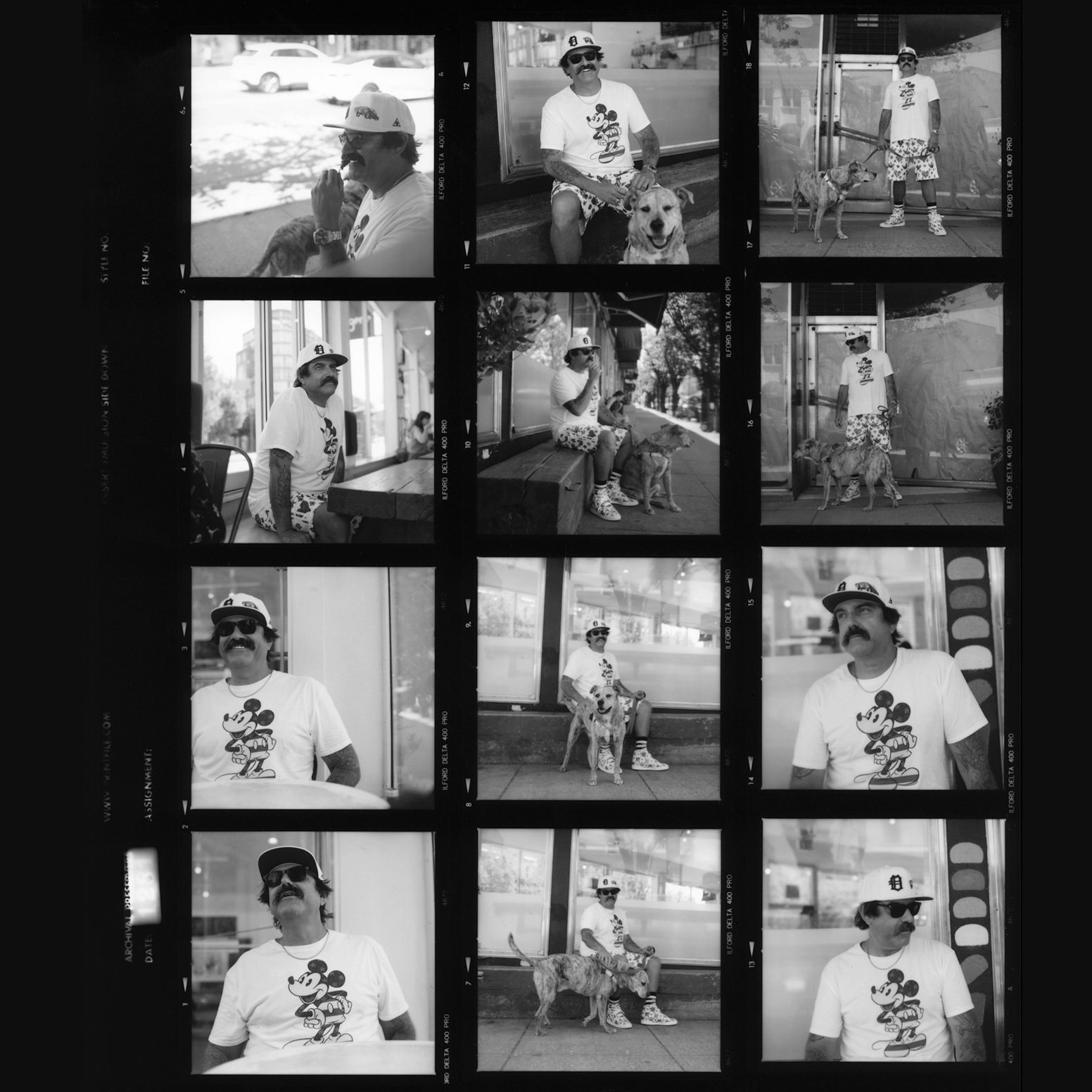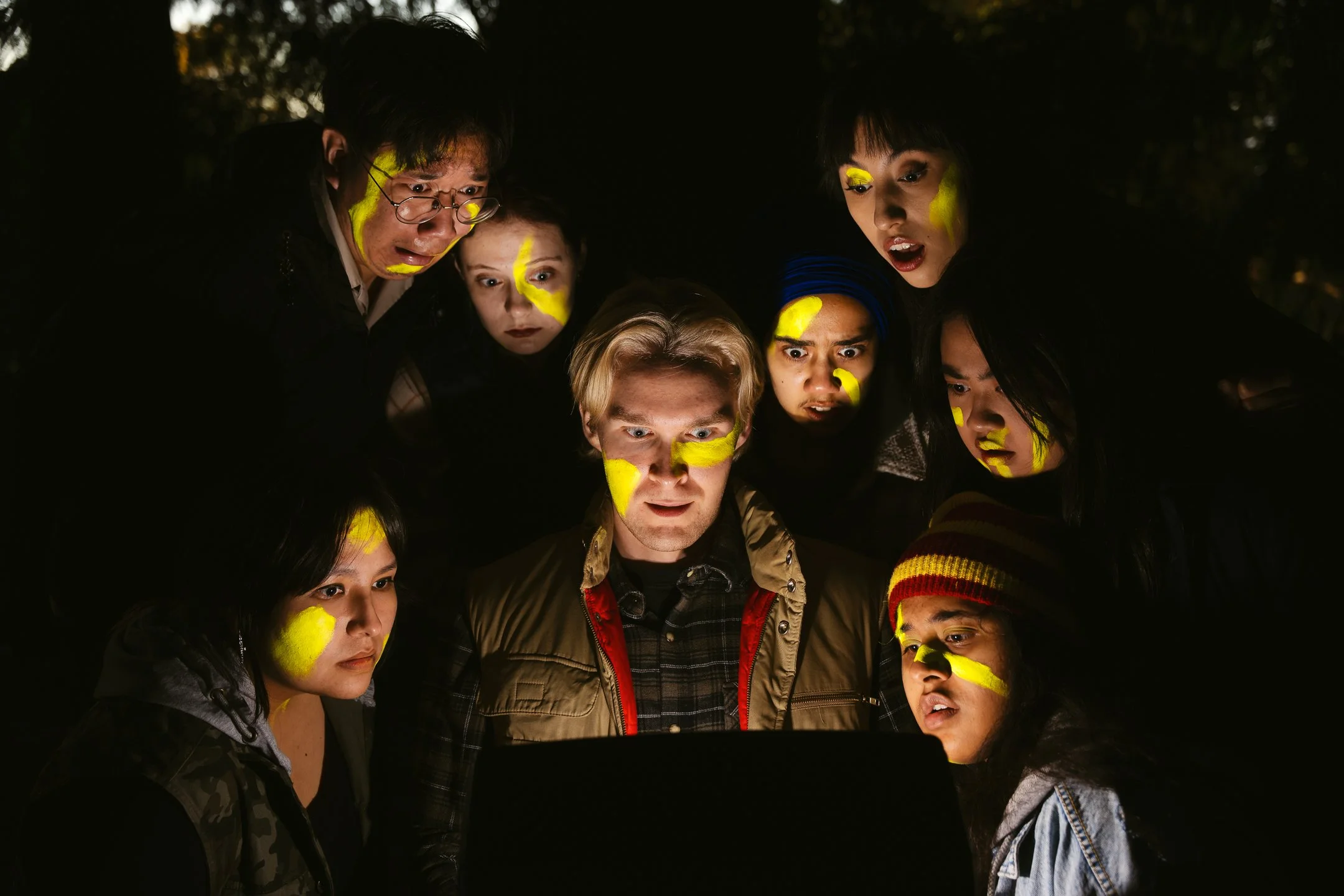Sell Out, A Series: 5 Questions with Jean Paul Langlois
/Sell Out is a series by interdisciplinary artist Angela Fama (she/they), who co-creates conversations with individual artists across Vancouver. Questioning ideas of artistry, identity, “day jobs,” and how they intertwine, Fama settles in with each artist (at a local café of their choice) and asks the same series of questions. With one roll of medium format film, Fama captures portraits of the artist after their conversations.
Jean Paul Langlois (he/him) is a Métis/WASP artist. Follow him on Instagram (@jeanpaullanglois), or visit his website at www.jeanpaullanglois.ca.
Location: Gene Coffee Bar Instagram
What do you make/create?
I make paintings - primarily large canvases, pretty colourful - trying to tell the story of me, and my family, my relationship to my heritage which I’m still trying to figure out, whatever lack of culture or culture that my family has. I tell stories through a series of paintings. They used to be very specific stories, but now my latest series is about my dad. About him going from lower working class to upper class through marrying my mom and going to university, sort of the troubles relating to class or caste. It’s a bunch of moments from his life and our relationship together, just trying to figure him out. He’s passed away, so there’s lots going on there and I’m, you know, dealing with grief through that and our complicated relationship. It goes down different rabbit holes and I’m still trying to figure that out. I’m up to six canvases so far, it’ll probably be twenty by the time I’m done, and maybe one day I’ll have a show.
I’m also a mural artist. For about five years I’ve been doing about one mural a year, pretty big ones. I guess I’m a filmmaker now, I’m working on my second short film. I did a thirteen-minute short about going across Canada, plein air painting, on a quest looking for the locations of three NFB films from my childhood. It was sort of well received. I haven’t really done much with it; I’ve done one screening with the NFB films with the locations that I was looking for. Then also I’m starting to work on sculpture - I really want to be able to express myself that way, but I’m terrible. I’m like a child so far, trying to do clay stuff and assemblage stuff. It’s coming together but it’s a slow process. My new hobby art is photography, and specifically candid street photography, which is fun and abrasive. I really love it. I can’t get enough of it. Maybe one day I’ll do something with that, but I’m a terrible photographer so it’s a slow process.
What do you do to support that?
It’s a grind, and a hustle. I’m in the studio five to seven days a week. Also doing lots of research and drawings. A lot of my work is inspired by, and the actual imagery is appropriated from, film and TV, or art history. I do a lot of reading. My titles all come from literature, some of the themes come from literature, so there’s lots of research time. I’ll watch, like, ten to twelve movies a week. I watch a lot of Westerns, Noir, Samurai films, old cheesy ‘70s TV shows I love. Lots of cartoons, I’m super inspired by cartoons, early Disney and Warner Brothers stuff. That takes a lot of time.
Then there’s the business around the business, which is lots of networking, all the email crap, the accounting crap - which I’ve been historically terrible at my whole life, so it’s really catching up. Adulting is not the easiest part.
Describe something about how your art practice and your “day job” interact.
My art practice is actually my day job now, and has been for a while. I am very grateful for that. I’ve been a very serious painter since I was a teenager, and so there’s some decades there that I was definitely not selling anything. I was showing, and getting some attention, but there was no income coming in from my art, so there were a bunch of day jobs.
I grew marijuana for many, many years and that allowed me to have the time to paint, which was nice. I was in the film industry for a long time, which was great because it’s a creative field, and there’s interesting people there. I found that learning how the film industry works fed my practice in some ways. Then I was a DJ - in the twilight of that mediocre career I was a strip-club DJ, wedding DJ, playing school dances, playing Donnelley clubs. It wasn’t really a heroic DJ career; I didn’t really get to play what I wanted. I was at my lowest common denominator, having to play Sweet Caroline and Save a Horse Ride a Cowboy more often than I wanted to. But, you know, there was some money there and it was a social and fun gig.
What’s a challenge you’re facing, or have faced, in relation to this and/or what’s a benefit?
For a while I almost stopped painting altogether. When I was growing dope, I used to smoke a lot of dope and it was really demotivating. I was watching a lot more TV and doing the bong hits than actually getting the brush out. The film industry, when I was really doing it a lot, I was in the grip department, doing long hours, sometimes six-day weeks. So of course on the weekend you’ve got nothing left, you can’t even do your laundry.
And then I have my dog, Fred, who is a big part of my life, and when I moved to Vancouver, he was just not having it. I’d just recently been divorced so there was nobody to look after him, so he’d have to go to doggy day-care - and he made it very clear that this career was no longer for me. I started doing less and less, more and more part-time. At that point in the industry, the key grips wanted you to be there every day or just not bother. I just worked less and less and painted more and more, and the more painting I did, the more serious people saw me being, and more opportunities came, and the next thing I knew I was a full-time artist. Thanks Fred!
Have you made, or created, anything that was inspired by something from your day job? Please describe.
There’s a couple angles there. I used to always DJ my own art openings; I like to control the soundtrack, but also it was a weird way to screen myself from the social anxiety of having to talk to people, instead of just double-fisting wine while I try to talk about my work. That was okay, but then I also have lots of DJ friends, so more and more they’d split it with me, and I ended up not having to DJ. In Culture Crawl, I DJ’d for four days and just brought all of my soundtrack records. I have a huge Spaghetti Western and movie soundtrack collection. It really created this creepy, awesome ambiance. It was easier to throw a record on and just walk away.
In the film industry, although I’ve only ever worked on absolute garbage - with some good actors, but really some terrible films and TV shows - the way that a film is made, with the different departments, scouting for locations, casting actors, costuming, props, set dec, camera angles, all that stuff carried through. When I do a big painting, that’s sort of how I put it together now: I scout for locations, find the background that I want, and then, say I have my mom and my dad in a painting, I’ll take actors that remind me of my parents. Like, for instance, my dad, maybe Brutus from a Popeye movie, or some big fat bearded guy from a Spaghetti Western, or my mom, I cast her once as Zira from Planet of the Apes because they wore the same outfits. When Zira went to earth in that one movie, my mom wore the same kind of polyester outfits, and she had the exact same haircut. When I showed her that painting, my mom was like, “Why am I an ape?”, and I was like, “You don’t understand, this is how my brain works, mom!” So yeah, I cast actors.
When there’s props in it, whether it’s wine, a gun, or whatever, you’ve got to research how that looks. My paintings are so flat and basic, I want to do the minimum amount of work so the symbol of the thing is there - but, you know, that takes work, lots of practicing. I still can’t make a glass of wine look like a glass of wine. I’m terrible. I mean, Renaissance masters can do that, El Greco can do that, but little old me has to make a cartoon glass of wine. That’s gonna be good enough, though, and people will say, “Oh, that’s a glass of wine.”
Angela Fama (she/they) is an artist, Death Conversation Game entrepreneur, photographer, musician, previous small-business server of many years (The Templeton, Slickity Jim’s etc.). They are a mixed European 2nd-generation settler currently working on the unceded traditional territory of the Coast Salish xʷməθkwəy̓əm, Skwxwú7mesh and Səl̓ílwətaʔ/Selilwitulh Nations.
Follow them at IG @angelafama IG @deathconversationgame or on their website www.angelafama.com









